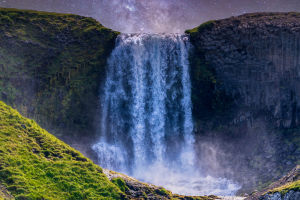Antelope is a herbivorous animal, it has a wide variety, graceful shape and light movement. Antelopes have slender limbs and small, pointed hooves. Antelopes are 60 to 90 centimeters tall, often in groups of 5 to 10, and some groups can be as many as hundreds.
Antelopes are widely distributed in highlands, plains, bushes and other places. Antelopes are gentle animals. Because of its small size, it is more sensitive and cautious than other animals. Antelope has a good sense of hearing and smell, which it has honed in its long-term solitary life.
In the vast grasslands , more than 60 different species of antelope live. Although they belong to the same family, they are very different in body and temperament.
1. African Oryx
The African eland is the largest species of all antelopes. Because of its huge stature and its upper horns turning a bit, it is also called the African spiny horned antelope.
The shoulder height of this antelope is generally between 172-178 cm, and the largest can reach 182 cm; the length of the body is between 2.80 and 3.30 meters; the weight is generally 600 kg, and the largest is almost 1 ton. Taller and stouter than a buffalo.
Its hoof hair is brown or grayish-yellow, with a slight white streak on the shoulders and back. Both male and female antelopes have horns, but the female horns are slender and the longest can reach more than 1 meter; the male horns generally do not exceed 90 centimeters.
2. Nanger Dama
Nanger Dama are herbivores. It has a strong physique and the males are larger and stronger. Cubs have thin legs, thin necks, and S-shaped horns. Nanger Dama have 4 toes on their feet, but the outer toes are more degraded than deer and are suitable for running.
Nanger Dama's fur is shiny with reddish-brown and white spots. The cheeks and underparts are always white, the neck is reddish-brown, and the throat is always spotted with white.
Nanger Dama live in deserts and jungles, and they live together in groups, usually in small groups of around 10-20, and migrate seasonally to form large groups of hundreds.
Nanger Dama lives in the Sahara Desert in Africa, moving south to feed during the dry season and returning to the north during the rainy season. Nanger Dama are herbivores, feeding on shrubs, grass blades, and rough desert grasses.
3. Doga Gazelle
The Dorga gazelle, also known as the fawn gazelle, is a herbivorous animal that mostly lives in grasslands and desert areas. This creature is found from North Africa all the way to India. It is able to adapt to life in the desert and can spend its life without drinking water.
Dorga gazelles generate water through food to maintain their own lives, and are very adaptable to the environment. It can also tolerate high temperatures.
Usually it will choose to come out at dawn and evening, mainly to avoid the capture of hunters. If the environment is very difficult, then they will migrate appropriately.
Dorga gazelles are very small and have long ears. Both females and males will have horns on their heads, but the females will have smaller and curved back feet, and the males will have large horns.
Depending on the region where they live, the coat color will also be somewhat different. The coat color in North Africa will be light brown, the skin care is white, and the coat color in the Sahara is darker, and there will be a lot of stripes on the face. Most of the Doga gazelle’s coats that live in Israel and the Red Sea are reddish-brown.


